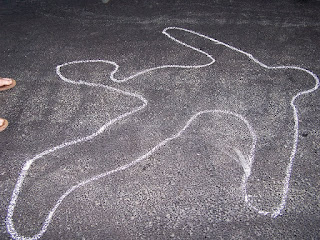This post first published on September 20, 2016. We hope it helps you with your #NaNoWriMo2017 novel revisions! ~ Dani G.
For example, I might write something like this:
I’ve found many benefits to this sort of outline:
These days I’m editing my novel, which is different from revision. Only after I’ve included the want, obstacle, conflict, change, and new want in each scene am I ready for a content edit. That’s when I make another pass to condense, expand, punch-up, clarify, and polish.
From drafting to revising to editing is a long journey. But I’ve found that outlining decreases the distance between those points.
 |
| Photo by Ron Bieber © 2006 (Flickr) |
I used to find it difficult to move on to writing the next chapter of a book until I had the previous chapter down solid. I used to write a draft, read it, then revise. Then I’d read the revision, feel something was still missing, and revise again. Thus began an endless loop of revisions, pursuing the illusion of a perfect chapter but making little progress on the book.
What’s an obsessive writer to do?
I’ve always refused to start with an outline because it makes me feel inhibited. My characters are unruly, and after just a few pages we’re wildly off-track. So I started my current novel based on a synopsis and a list of “things that might happen,” which I believed was a smaller time investment. But when I began revising each chapter ad-nauseum, I knew I was not saving time at all.
Then I learned a simple notion: there’s more than one way to outline. On the advice of Lighthouse Writers Workshop instructor and author Doug Kurtz, I now outline each chapter after I write it. This method, which I feared might inhibit creativity has instead more than doubled my productivity while increasing my creative freedom. The best part: I no longer ride the revision merry-go-round.
Here’s the basic outline I briefly fill out after drafting each chapter:
Chapter Number/Name
Scene One: Simple phrase that captures the scene
Scene One: Simple phrase that captures the scene
Main Character: Name
Secondary Characters: Names
Want: What does the main character want at the start of the scene?
Obstacle: What is the obstacle that gets in the way?
Conflict: What is the resulting conflict?
Change: What changes as a result of the conflict?
New Want: What’s the new thing the main character wants now that things have changed?
As I describe the five above scene elements—1) Want, 2) Obstacle, 3) Conflict, 4) Change, 5) New Want—I inevitably have trouble answering one or more questions. That’s how I discover which elements need development. Then I note the missing elements in red—that meanie editor’s color, but, hey, it stands out.
For example, I might write something like this:
Chapter One: The Gold Coins
Scene One: The Safe Combination
Main Character: Jo
Secondary Character: Ky
Want: Jo wants the gold coins that will secure the release of her kidnapped child.
Obstacle: Her friend, Ky, won’t give her the combination to the safe. (Wouldn’t it be a more dramatic obstacle if Ky insists Jo admit the kidnapping was her fault before she’ll reveal the combination?)
Conflict: Jo and Ky argue about whether or not to give the coins to the kidnappers and they both blame each other for the kidnapping (The blame is not yet on the page. Should it be spoken or unspoken? If unspoken show interior monologue.)
Change: Ky agrees to open the safe, but only if Jo calls police. Jo is outraged. (Punch up Jo’s outrage.)
New Want: Jo wants to crack the safe without Ky’s help.
I write an outline for every scene. Once I’ve noted the needed revisions in red, I put off revising and draft the next chapter.
I’ve found many benefits to this sort of outline:
1) It gets me unstuck from repeatedly revising one chapter, because I’ve identified all the missing elements in one fell swoop.
2) It clarifies the purpose of the needed revisions in terms of plot development, so I know what to do.
3) It keeps me moving forward because, instead of feeling I have to fix everything now while it’s on my mind, I let the outline remember for me what to do later.
4) It prevents wasting time on revisions that might later be dropped if the book changes course.
5) When it’s revision-time, my course is laid out so I can finish most of it in one pass.
Sure, revisions can still take me months, but my old way would have taken me years, because I was feeling my way around for what my gut said rather than identifying clear plot requirements like: hey, you forgot the conflict!
These days I’m editing my novel, which is different from revision. Only after I’ve included the want, obstacle, conflict, change, and new want in each scene am I ready for a content edit. That’s when I make another pass to condense, expand, punch-up, clarify, and polish.
From drafting to revising to editing is a long journey. But I’ve found that outlining decreases the distance between those points.
 |
| Cara Lopez Lee is the author of the memoir They Only Eat Their Husbands. Her stories have appeared in such publications as The Los Angeles Times, Denver Post, Connotation Press, Rivet Journal, and Pangyrus. She’s a book editor and writing coach. She was a faculty member at Lighthouse Writers Workshop, a journalist in Alaska and North Carolina, and a writer for HGTV and Food Network. An avid traveler, she has explored twenty countries and most of the fifty United States. She and her husband live in Ventura, California. |


Even if you do an outline before, you have to still do a summary chapter analysis after to make sure you have ticked all the boxes. And my timelines always get messed up even if at the top of the scene I have written details: day, time, place, etc. My characters don't behave at all. :)
ReplyDeleteI'm glad to know you go through a similar process, Diana, and that your characters don't behave either. Writing a novel is an insane process unless we impose a little sanity - at least a drop. ;)
DeleteThis comment has been removed by the author.
ReplyDeleteThis comment has been removed by the author.
ReplyDeleteWhoa ... Cara, you may have just kicked Homey's mind into gear ... it has been stuck in neutral for ... well, long enough for things to start rusting. This outline thing might just be the WD-40 I've needed!
ReplyDeleteWow, that makes me happy, Christopher. Sometimes I'm not sure whether my process will be helpful to others or not. I really thought I would hate outlining, but it has helped give me so much clarity on my story.
DeleteGreat post, Cara! I'm going to keep this all in mind as I learn Scrivener. I'm going to miss you on the blog. Promise you'll come back as a guest!
ReplyDeleteThanks, Dani. It's always a battle, getting my right brain and left brain to work together, and as far as I'm concerned successful writing is not an either-or proposition in that regard. I'll miss you too, and I'm so grateful you've asked me to return as a guest - because I really don't want to say goodbye. :) I'm in.
DeleteFirst I had duplicate posts; then I had none. I just tried again to post, and it didn't work. ??? So here we go once more. This is an intriguing idea, Cara. I'm giving it serious consideration. :-)
ReplyDeleteThanks, Linda! The method I describe is a combination of a tip from another writer and my own approach. None of us can tell another how to best grow in the creative process, but we can listen for ideas that resonate and shape them into something all our own.
DeleteWonderful post Cara. I use a similar tracking system to make sure I remember what is in each chapter and each scene, but I had not added the numbered check list you gave us as an example. Like Linda said, I'm going to try it. Makes perfect sense to doublecheck those elements as well as the action in a scene.
ReplyDeleteSo cool to know these practices work for others. I seem to recall an author - I believe it might be Doug Kurtz, whom I mentioned in this post - who tracks his plots on the wall of his office! Or so his wife says...
DeleteI've never been an outliner, but this seems like something even I can handle. Just recently, I wrote half a book, got to a point where the plot had nowhere to go, and was too outrageous even for me. I'll go back to it some day and try your technique. I'll miss you too, Cara. Your posts have been terrific.
ReplyDeleteThanks, Polly. I deeply appreciate the appreciation. I hear you on outlining. I hated the idea of outlining a novel until I started doing it this way. I'm still surprised how many writers saw the title of this post and read it anyway - in the past it would have sent me running. ;)
DeleteThanks Cara, I am going to bookmark this one for reference. Very helpful and insightful! I've pretty much used up the 'years' I can spend on rewriting/editing and hopefully this will help me move forward faster on future projects. Cheers!
ReplyDeleteSo glad you found it helpful. I've really noticed a difference in the efficiency of my process, and I hope you do too.
DeleteI admire your ability to be so specific with your scenes. During major rewrites of my first and second novels, I followed the original detailed sketches of main characters and less detailed ones of secondary characters, the same ones I had created when the stories were first penned. My story lines are roughly laid out because my characters have a bad habit of showing me I don't always know what they are thinking or what direction they're taking. For example, the ending of my first book was written in stone, or so I thought. However, my antagonist let me know as the first climax approached it wasn't going to happen that way. He was right. So again, I wish I could be as precise as you are, but my mind doesn't seem to function in such a logical way. Great repost and great information. :-)
ReplyDeleteI do something similar - writing a scene summary after I've written the scene - but I really like this idea of filling in a worksheet of sorts to find missing elements. Great post.
ReplyDelete